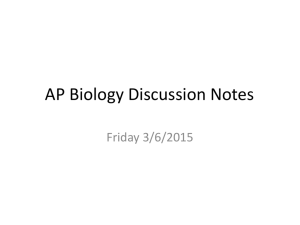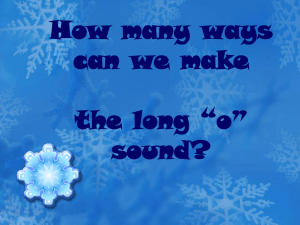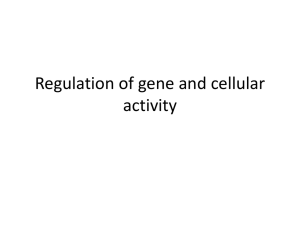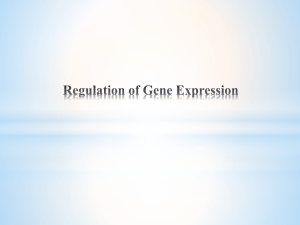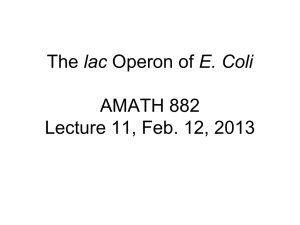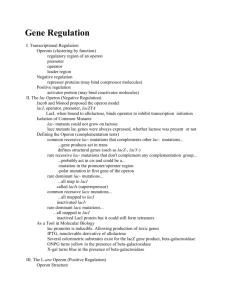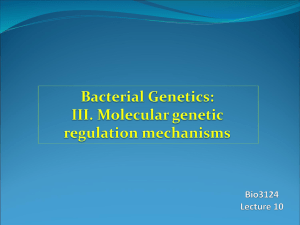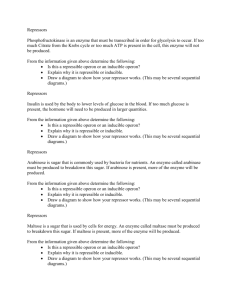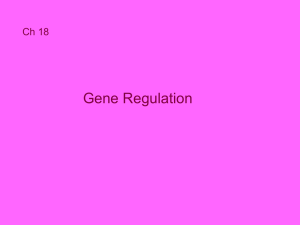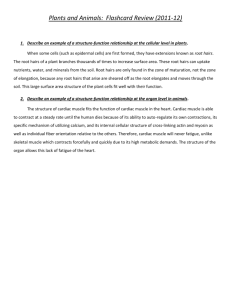File - Pomp
advertisement
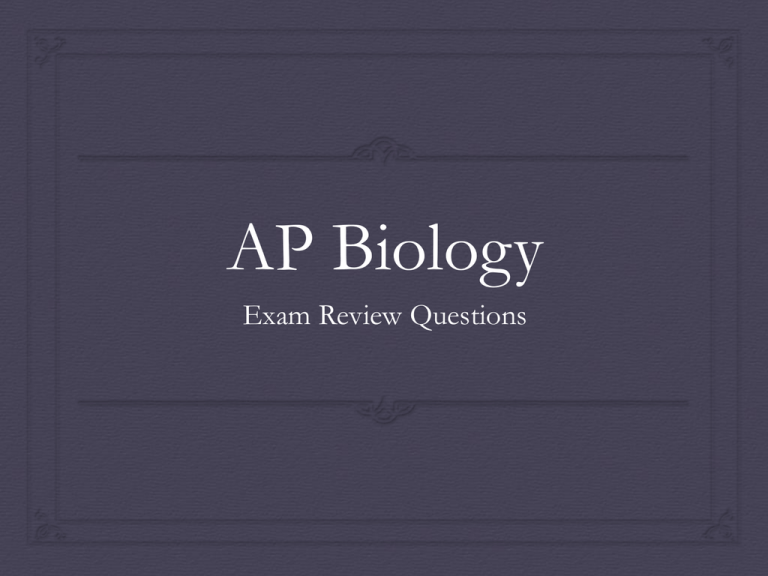
AP Biology Exam Review Questions 1. Surface to Volume Simple cuboidal epithelial cells are associated with tissue that function in glandular secretions. Comparing three different cells sizes; a) 10 μm/ side b) 20μm/ side and c) 30μm/ side, calculate the following: A. Make up a formula to represent surface area, and use it to calculate surface area for all three cells. B. Make up a formula to represent volume, and use it to calculate volume for all three cells. C. Determine surface area to volume ratio for all three cells. D. Which of the three cuboidal cells would be most efficient at transporting nutrients into the cell through diffusion? Why? E. Which cell is more likely to go through mitosis? Why? 2. Peptides: Draw two basic amino acid structures in optimal position to form a dipeptide. Hardy Weinberg: In a population of certain bubble guppies in which the allele for blue skin is dominant to the allele for turquoise skin, an under water volcano leads to the selection against turquoise skinned bubble guppies. When the volcano stops erupting, 14 percent of the remaining bubble guppies are turquoise. If the population is now in Hardy- Weinberg equilibrium, what would the frequency of the turquoise allele in bubble guppies of the next generation be? Tonicity: In terms of tonicity, explain what would happen to a freshwater fish that is placed into a salt water environment. Also, explain why hospitals use a 0.9% salt solution to rehydrate patients suffering, among other things, dehydration. What would result if straight water or a 2.0% salt solution were used? 6. Describe the picture: 7. Immune System Describe the process of a pathogen being consumed by the innate immune response. What types of cells do the consuming? Examples? How is the pathogen recognized? What happens to the pathogen once inside the cell? 8. Mechanisms of Evolution: Name and describe the three mechanisms of evolution that affect allele frequency. 9. Types of Natural Selection: Name the types of natural selection: 10. Genetics An organism AaBBCcDd is crossed with an organism AaBbCcDD. Without working out the entire cross, determined the expected frequency of an offspring with the genotype aaBbCcDd. 11. Biological Species Concept What is the biological species concept? What are some of the barriers that could impede members of different species from interbreeding? What are some other species concepts? 12. Metabolic adaptations of prokaryotes: Describe the difference between a photoautotroph and chemoautotroph. Describe the difference between a photoheterotroph and chemoheterotroph. 13. Feedback Systems What are positive and negative feedback systems (loops)? Can you give an example of both? #14: Lac operon 1. What are the components of an operon? 2. Is the operon model depicted utilizing lactose or is it inactive? 3. Is the lac operon a repressor operon model or an inducible operon model? Explain. #15 Constructing a Cladogram: #16 Chi Square A scientist predicts that the kittens born with a congenital birth defect will be 25% based on the hypothesis that it is caused be a recessive gene in that breed of cat. After surveying several litters, he found that 44 out of 125 kittens had the defect. Is his hypothesis correct? #17 Chi Square . A poker-dealing machine is supposed to deal cards at random, as if from an infinite deck. In a test, you counted 1600 cards, and observed the following: Spades 404, Hearts 420, Diamonds 400, Clubs 376 Could it be that the suits are equally likely? Or are these discrepancies too much to be random? #18 Hardy- Weinberg In 1848, the pepper moth population consisted of 98% white and 2% black moths. By 1895, do to the onset of the industrial revolution, the population had shifted to 95% black and 5% white moths. Calculate all genotypic and allelic frequencies for the 1895 moth population. Homozygous white = ww Heterozygous Black = Ww Homozygous Black = WW Answer to #5: A fresh water fish exists in a hypotonic environment where the solute concentration of its tissue is greater than the environment, therefore, water will naturally want to move into the tissue. The fish is designed to pump excess fluids out If the same fish is place in salt water, the environment changes to hypertonic where the solute concentration is greater than the fish’s tissue. Water will naturally run out, combined with the fish’s design to pump water out will result in crenation. Hospitals use a .9% salt solution as an intravenous fluids to maintain the isotonic environment between RBC and blood fluids. If concentration is too high, crenation would result, if concentration is too low, cell lysis would result. Answer #6 Transduction is a process where bacterial genetic information is exchanged from a donor bacterium to a recipient bacterium via a bacteriophage. Recombination occurs in the recipient bacterium resulting in a change in the recipient’s genotype Answer #7 One part of the innate immune response is the secretion of phagocytic cells such s macrophages (neutrophils, dendritic cells and eosinophils are some other phagocytic cells) Phagocytic cells recognize and attach via surface receptor (polysachharides) found on the microorganisms but not on normal body cells. Once recognition and attachment occurs, then the pathogen is consumed (engulfed) and fuses with a lysosome. The action of the lysosome will ultimately destroy the pathogen and the cell will exocytose the contents out of the cell. Answer #8 Genetic drift- unpredictable fluctuations of allele frequencies from one generation to the next Bottleneck effect- sudden changes in the environment causing the loss of an allele from a small population Founders effect- new population being established from the isolation of a few individuals from a larger population Gene flow: gaining or losing of alleles resulting from the movement of fertile individuals or gametes Natural Selection: individuals within a population exhibit variations in their heritable traits, and those with variations that are better suited to their environment tend to produce more offspring than those with variations that are less suited. Answer #9 I. Directional II. Disruptive III. Stabilizing IV. Directional Answer #11 The biological species concept defines a species as a population or group of populations whose members have the potential to interbreed in nature and produce viable, fertile offspring with members of another population. hinges on the potential to interbreed Prezygotic and post zygotic barriers Habitat, temporal, behavioral, mechanical and gametic isolation Reduced hybrid viability, reduced hybrid viability and hybrid breakdown Morphological, paleontological, ecological, phylogenetic species concepts Answer #12: Photoautotrophs are photosynthetic organism- use light energy to synthesize organic compounds Chemoautotrophs use inorganic substances such as H2S, NH3, Fe3+ and CO2 to build organic compounds Photoheterotrophs use light energy but get carbon source form organic compounds and not CO2 Chemoheterotrophs consume organic compounds as source of carbon and energy. Answer #13 Negative Feedback Systems: any deviation or variation from a set point or normal limits is made smaller or corrected. maintains a Homeostasis: Three components: receptors, control center, effectors Examples: Thermoregulation Hormone control Answer #13 cont. Positive Feedback system: any deviation or variation from a set point or normal limits is enhanced or made greater. non- homeostatic and not as common as negative feedback Moves away from homeostasis and can be fatal Examples: Contractions during birth Exercise and blood pressure Hormone secretion Decrease in blood pressure Answer #14: Operon is composed of a 1)promoter (DNA sequence recognized by RNA polymerase), 2) operator(controls RNA polymerases access to genes) and 3) associated genes. The repressor protein is attached to the operon therefore inactivating it. Lactose is not being utilized. Lac Operon model is the inducible model. Lactose acts as the inducer which attaches to the repressor removing it from the operon an allowing the transcription of the associated genes. Answer #15 Answer #16 Observed – 44 Expected – 31.25 O-E = 12.75 (O-E)2 = 162.6 (O-E)2/E = 5.202 The critical value for P= .05 is 3.841, the null hypothesis is rejected. Answer #17 Observed: Spades 404, Hearts 420, Clubs 376, Diamonds 400 Expected: 400 each Spades = (O-E)2/E =.04 Hearts = (O-E)2/E = 1 Clubs = (O-E)2/E =1.44 X2 = 2.48 Critical value for 3 degrees of freedom is 7.815, null hypothesis is accepted. Answer #18 q2 = .05 = ww q = .22 = w p = 1- q = 1- .22 = .78 = W p2 = .61 = WW 2pq = 0.34 = Ww
